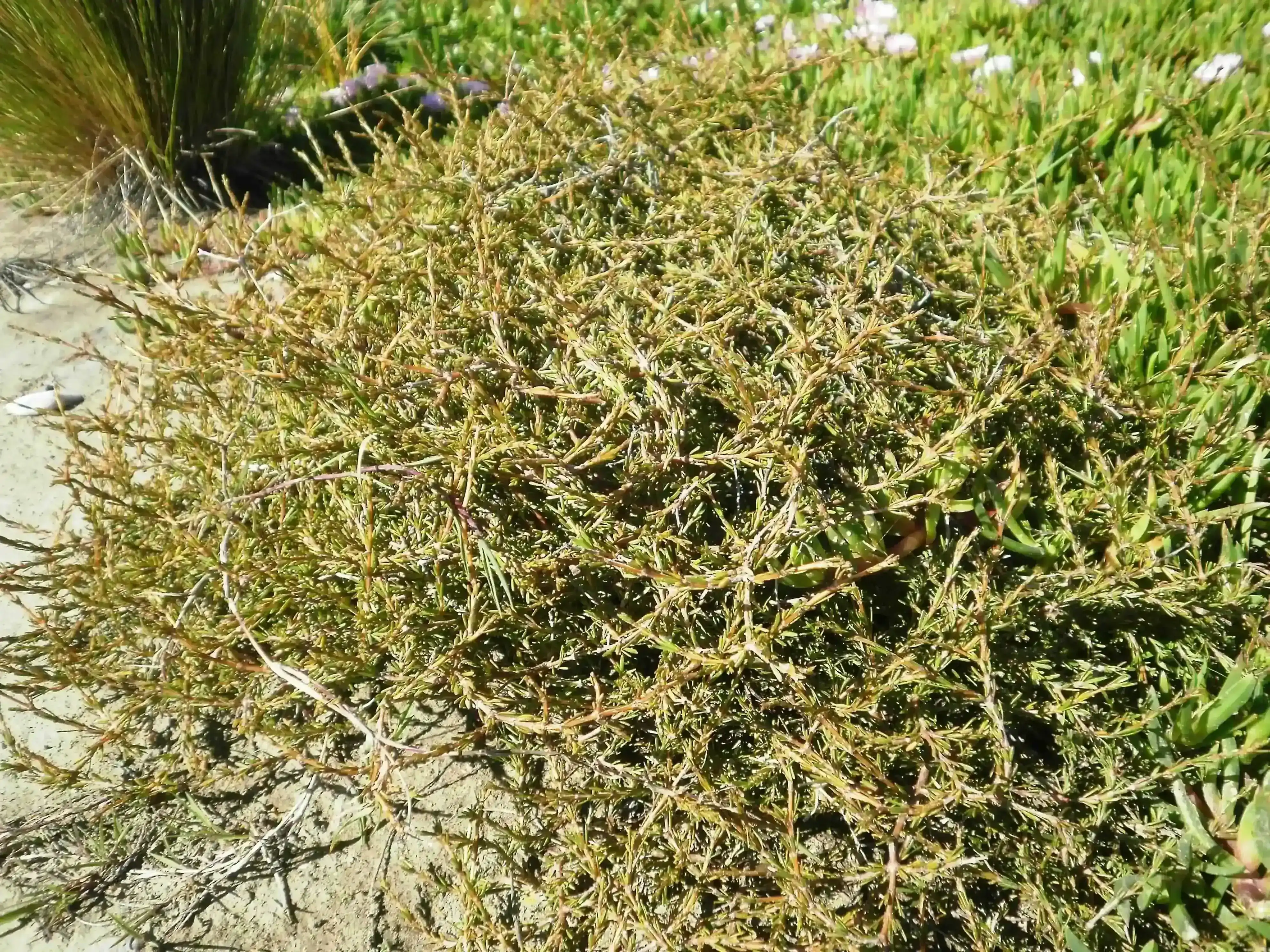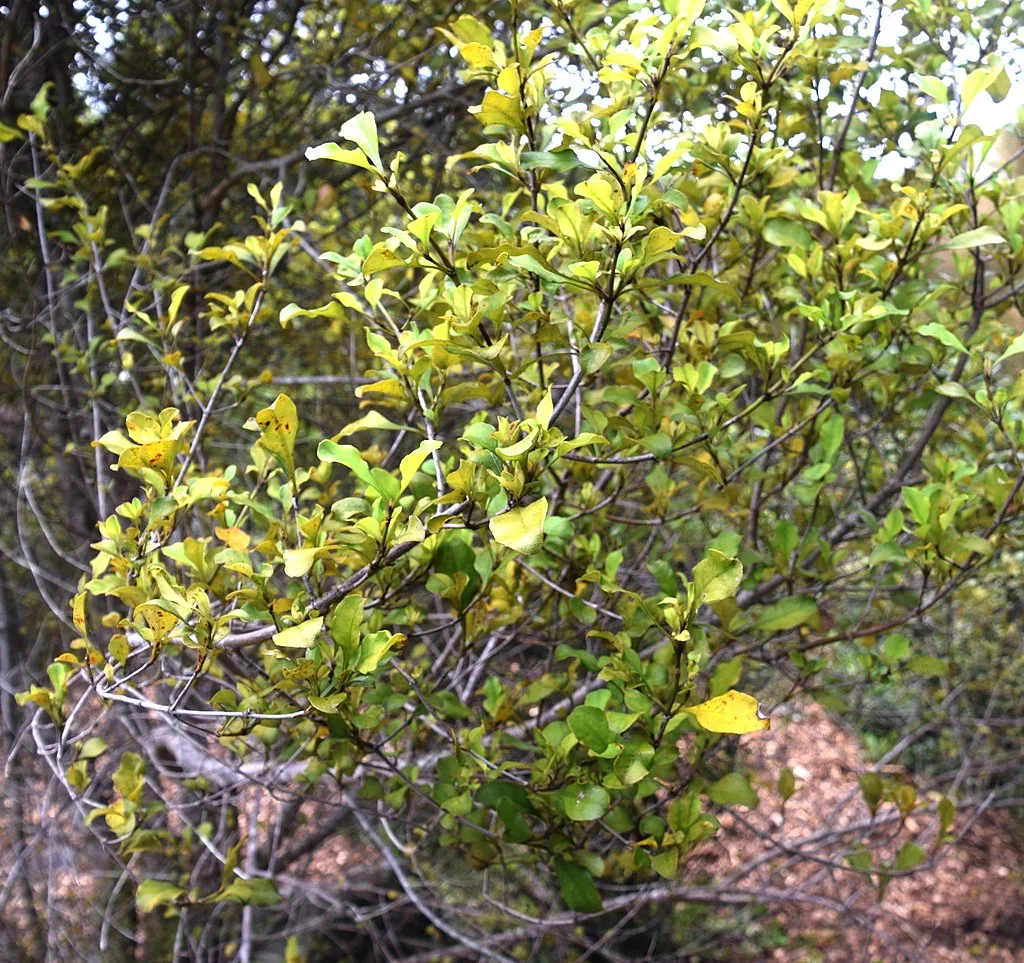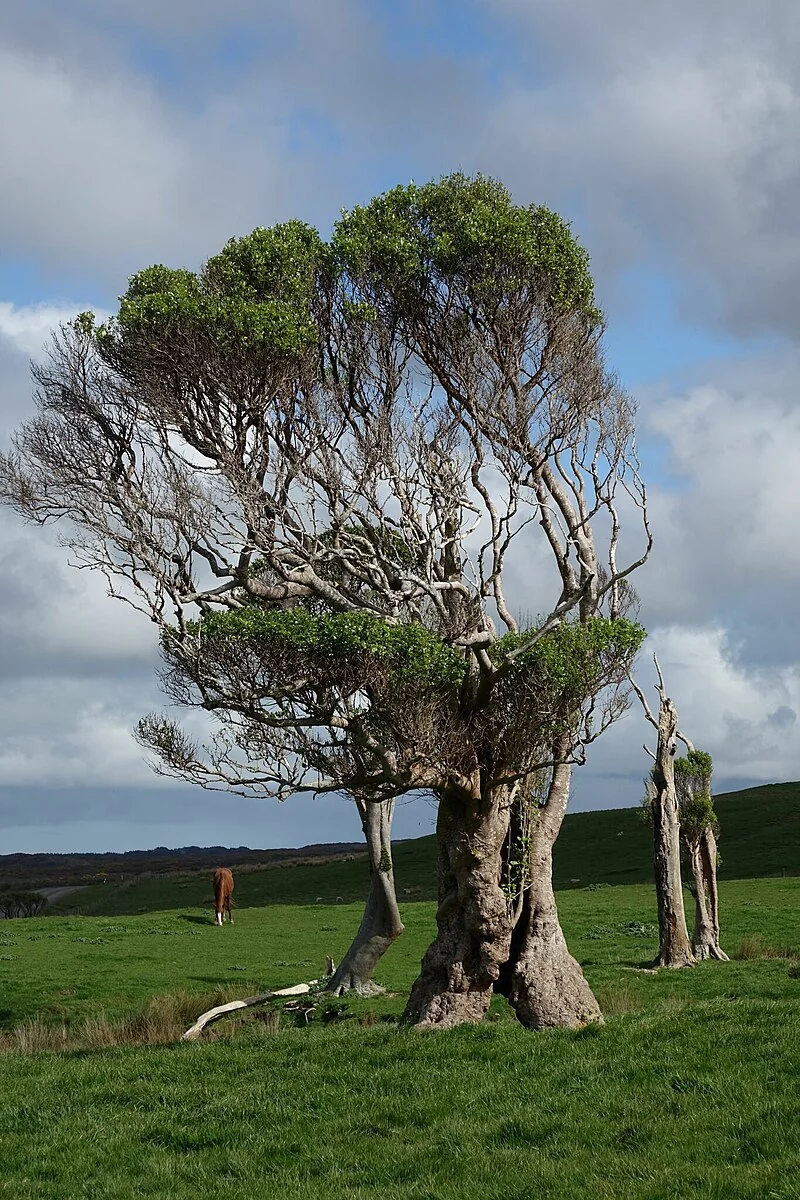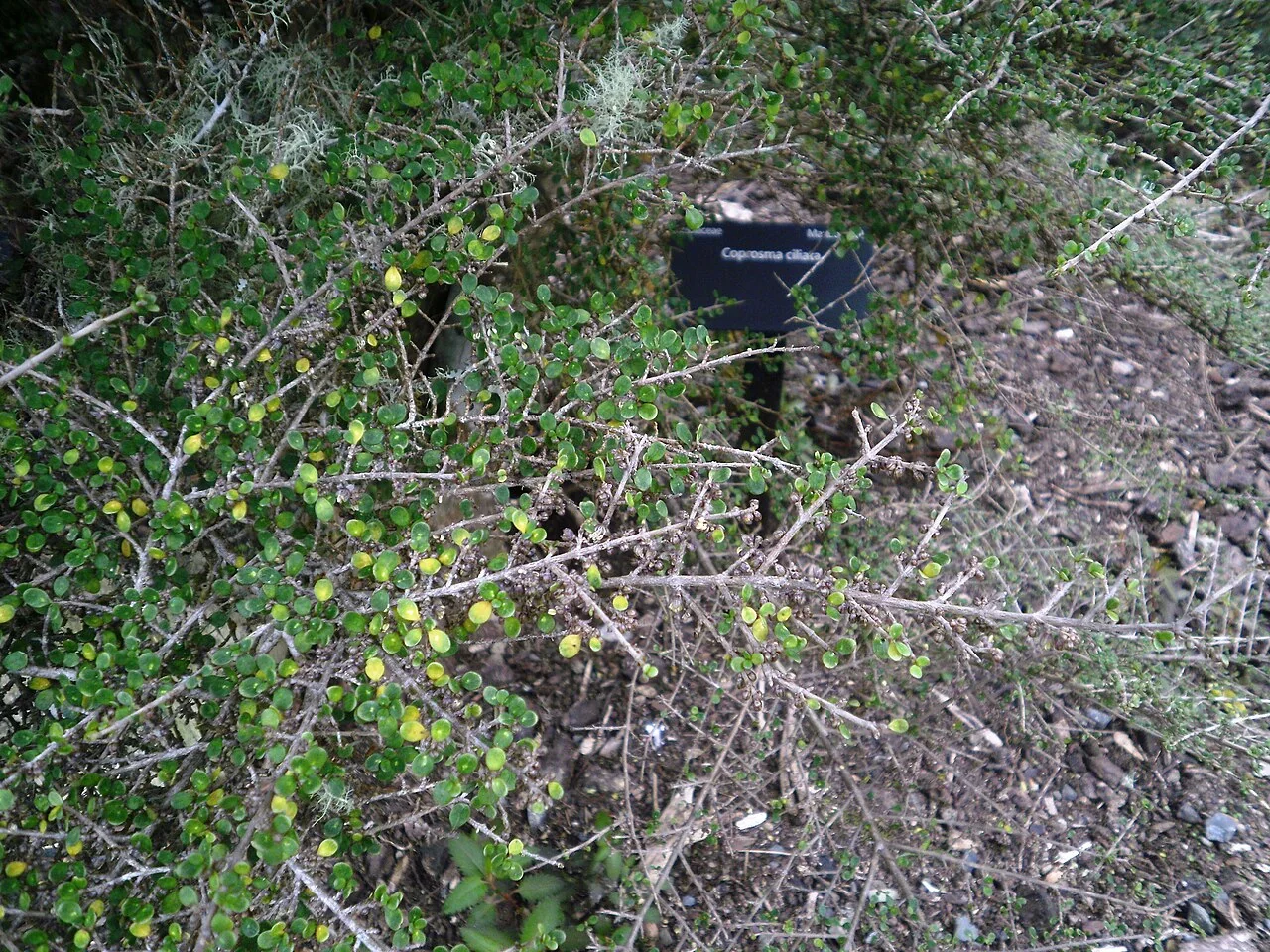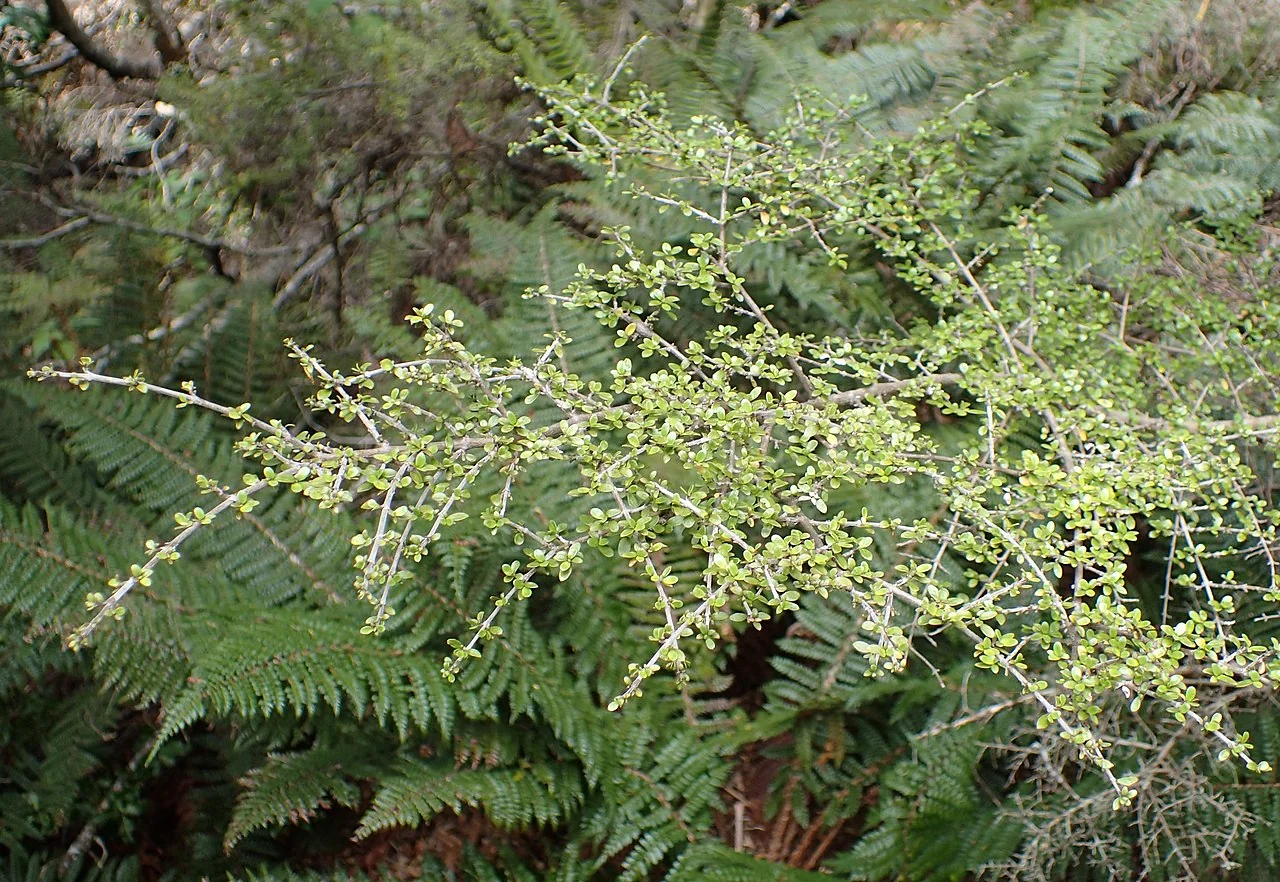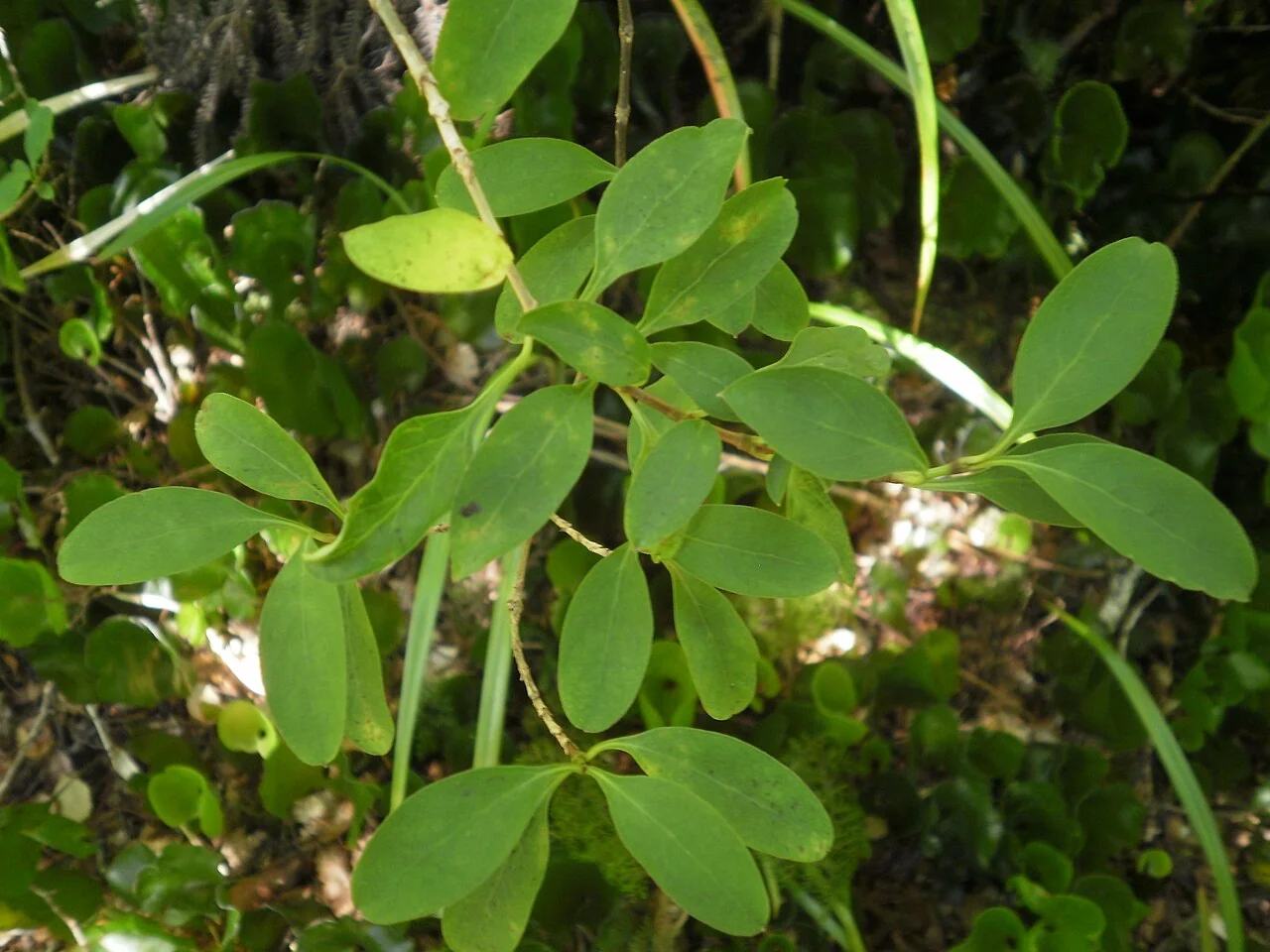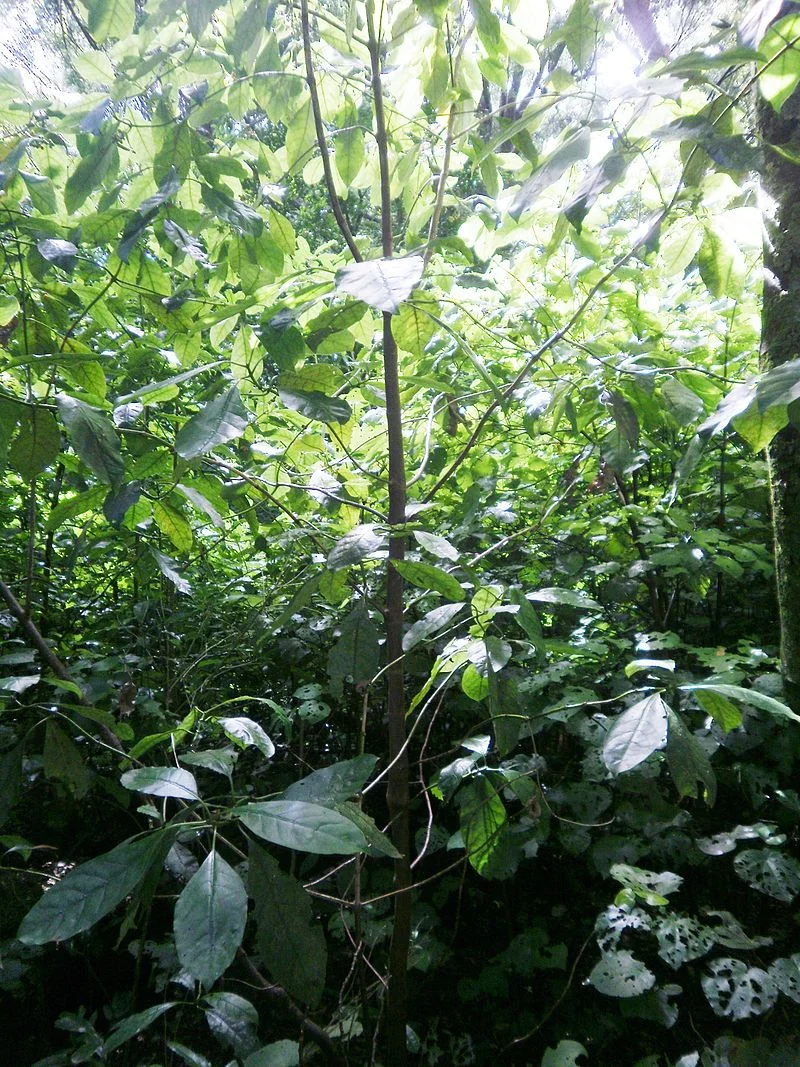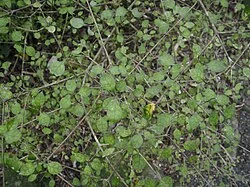
Thin-Leaved Coprosma
Coprosma areolata
Coprosma areolata , commonly known as thin-leaved coprosma, is a shrub among New Zealand's native shrubs native to New Zealand. It typically grows as a bushy shrub or small tree, reaching up to 3 to 5 meters (16 feet 5 inches) tall. The leaves are broadly elliptic, thin, and range from yellow-green to brown-green. They have a conspicuous reticulated (net-like) venation and a pointed tip. Small pits, called domatia, are found on the underside of the leaves where lateral veins meet the midrib. The flowers are small and inconspicuous, typically 1-2 mm in diameter, and green in colour. It produces dark purple to almost black, globose berries, about 4-5 mm in diameter. Coprosma areolata is an endemic species found in lowland to lower montane forests throughout New Zealand, and can also grow in exposed places.

Plant Description
Botanical Features
Coprosma areolata , commonly known as Thin-leaved Coprosma, is a shrub or small tree native to New Zealand, growing up to 3 to 5 meters tall. It has a leafy appearance with slender, often upright branches. Its distinctive leaves are thin, yellow-green to brown-green, and typically broad-elliptic to obovate, measuring around 9-10 mm by 7-10 mm. A key characteristic is the prominent reticulated (net-like) venation visible on the leaves, and small pits (domatia) are often found on the underside where lateral veins join the midrib. The flowers are small and inconspicuous, typically green and 1-2 mm in diameter, followed by dark purple to almost black, globose fruits (drupes) that are 4-5 mm in diameter. This species thrives in wet, lowland forests but can also grow in exposed places.
Quick Facts
| Scientific Name | Coprosma Areolata |
|---|---|
| Height | 1-3 m |
| Spread | 1-2 m |
| Water Needs | Low to moderate |
| Light | Full sun to part shade |
| Frost Tolerance | Good |
| Salt Tolerance | Good |
| Growth Rate | Moderate |
| Lifespan | Long |
Climate Best Suited to
Thin-leaved Coprosma ( Coprosma areolata ) adapts well to various New Zealand climates, preferring areas with consistent moisture and protection from harsh winds. It adapts well to typical New Zealand growing conditions with appropriate care and positioning.
Regional Suitability
| Whangārei | Ideal |
| Auckland | Ideal |
| Hamilton | Suitable |
| Rotorua | Suitable |
| Tauranga | Ideal |
| Gisborne | Ideal |
| New Plymouth | Ideal |
| Whanganui | Ideal |
| Palmerston North | Suitable |
| Napier | Ideal |
| Wellington | Ideal |
| Nelson | Ideal |
| Christchurch | Suitable |
| Dunedin | Suitable |
| Invercargill | Suitable |
| City | Climate Suitability |
|---|
Natural Habitat
Typical Environments
Thin-leaved Coprosma ( Coprosma areolata ) is a native New Zealand shrub found throughout the North, South, and Stewart Islands. Its natural habitat primarily includes wet, lowland, and lower montane forests, where it often grows as an understory shrub. This species is also remarkably adaptable and can be found in more exposed areas, demonstrating its resilience to varying environmental conditions. It thrives in environments with consistent moisture and can tolerate a range of soil types, provided there is adequate drainage. Its widespread distribution across New Zealand highlights its ability to adapt to diverse ecological niches within the country's native bush.
Plant Conservation
Coprosma areolata , also known as thin-leaved coprosma, has a conservation status of "Not Threatened". This status has been consistently reported in assessments of New Zealand indigenous vascular plants, including those from 2012, 2017, and 2023. It is an endemic taxon to New Zealand, found on the North, South, and Stewart Islands.
Growing Requirements
Soil Requirements
Thin-leaved Coprosma ( Coprosma areolata ) performs best in well-draining soil that retains adequate moisture. Like most New Zealand natives, it prefers soils that don't become waterlogged but maintain consistent moisture levels. Good drainage is essential for healthy root development.
- Well-draining soil essential for healthy growth
- Prefers consistent moisture without waterlogging
- Adapts to various soil types with good drainage
- Benefits from organic matter incorporation
- Mulching helps retain moisture and suppress weeds
Light Requirements
Thin-leaved Coprosma ( Coprosma areolata ) performs well in full sun to partial shade conditions. Like many New Zealand natives, it adapts to various light conditions but typically shows best growth and form in positions that receive adequate sunlight throughout the day.
- Full sun to partial shade positions
- At least 4-6 hours of direct sunlight daily
- Tolerates light shade in warmer climates
- Morning sun particularly beneficial
Water Requirements
Thin-leaved Coprosma ( Coprosma areolata ) requires regular watering during establishment, typically for the first 1-2 years. Once established, it becomes more drought-tolerant but benefits from consistent moisture during dry periods. Avoid overwatering which can lead to root problems.
- Regular watering during establishment phase
- Moderate drought tolerance once established
- Consistent moisture during dry periods beneficial
- Avoid waterlogged conditions
- Mulching helps conserve soil moisture
Planting Guide
When to Plant
The best times to plant Thin-leaved Coprosma ( Coprosma areolata ) are during autumn or spring. These seasons offer moderate temperatures and reliable moisture, which are ideal for root establishment. Avoid planting during periods of extreme heat, drought, or heavy frost.
How to Plant
Choose a site that receives full sun to partial shade, ideally with morning sun and afternoon shade, and some protection from strong drying winds. Thin-leaved Coprosma thrives in well-drained soil with moderate moisture. Amend heavy clay soils by adding extra topsoil and forming raised beds, or by incorporating coarse sand, bark, peat, or compost to improve drainage. Dig a hole that is twice the width and depth of the plant's root ball. Gently tap the plant out of its pot, being careful not to disturb the roots. Place the plant in the hole so that the top of its roots are level with the surrounding ground. Backfill with the amended soil, gently firming it around the plant. Water thoroughly immediately after planting with an organic garden booster. Apply a layer of mulch around the base of the plant, keeping it away from the trunk, to suppress weeds and conserve moisture.
Ecological Role
Environmental Benefits
Coprosma areolata , commonly known as thin-leaved coprosma, plays several important ecological roles within New Zealand's forest ecosystems.
- Understory Species: It serves as a significant understory species, providing essential habitat structure and contributing to overall forest health.
- Food Source: The plant produces abundant small orange to dark purple or black berries, which are a crucial food source for native birds such as silvereyes and fantails. These birds, in turn, aid in the dispersal of its seeds.
- Habitat Provision: Its dense, fine branching offers microhabitats and shelter for various invertebrates and small animals. It also provides habitat for lizards.
- Pollinator Support: The small, inconspicuous flowers of Coprosma areolata support native flies and other pollinating insects.
- Ecosystem Structure: By contributing to the complex layer structure of the forest understory, it enhances overall ecosystem function and biodiversity.
Uses and Significance
Garden Uses
- Excellent for native plant gardens and restoration
- Suitable for naturalistic landscape designs
- Low maintenance once established
- Contributes to local biodiversity
- Attractive to beneficial native wildlife
Cultural Significance
Traditional Uses and Values
Thin-leaved Coprosma ( Coprosma areolata ) holds cultural significance as part of the diverse Coprosma family, many species of which were traditionally used by Māori for various purposes, including medicinal applications (rongoā) and as food sources. Its presence in forest ecosystems also contributes to traditional ecological knowledge, highlighting the interconnectedness of native flora and fauna.
Landscaping Applications
Thin-leaved Coprosma ( Coprosma areolata ) is a versatile and attractive evergreen shrub highly valued in New Zealand landscaping for its delicate appearance and ecological benefits. Its adaptability to various conditions makes it suitable for a range of garden designs:
- Hedges and Borders: Its dense and leafy form makes it an excellent choice for creating low hedges or defining borders, adding texture and year-round interest to the garden. It responds well to trimming for shape and size control.
- Mixed Plantings and Woodland Gardens: Commonly incorporated into mixed native plantings, it thrives in woodland gardens or shady areas due to its tolerance for partial to dense shade, mimicking its natural understory habitat.
- Stream and Pond Areas: Suitable for plantings around water features like streams and ponds, contributing to riparian zone restoration and naturalistic designs.
- Informal Screening: Can be used to create informal, naturalistic screening, offering privacy and an elegant seasonal interest with its fine-textured foliage.
- Container Planting: Its manageable size makes it a good option for container planting on patios, balconies, or in smaller garden spaces.
- Erosion Control and Revegetation: As a hardy native, it is valuable for revegetation projects and can tolerate exposed sites, helping to stabilize soil.
- Wildlife Gardens: The abundant small, dark purple berries provide crucial nutrition for native birds like silvereyes and fantails, making it an essential plant for attracting and supporting local wildlife. Its dense branching also creates microhabitats and shelter for invertebrates and small animals.
- Textural Interest: The delicate leaf structure and airy habit provide subtle texture and fine-textured foliage contrast in mixed native plantings.
Seasonal Care Calendar
Spring
Spring is an active growth period for Thin-leaved Coprosma ( Coprosma areolata ). New growth emerges and this is an ideal time for planting new specimens. Monitor soil moisture as temperatures warm and growth accelerates.
- Active growth period with new foliage development
- Ideal time for planting new specimens
- Monitor soil moisture as temperatures rise
- Apply organic mulch if needed
Summer
Summer is typically the main growing season for Thin-leaved Coprosma ( Coprosma areolata ). Ensure adequate watering during hot, dry periods, especially for young plants. Established plants show good heat tolerance with appropriate care.
- Peak growing season with active development
- Monitor watering needs during hot weather
- Young plants need consistent moisture
- Established plants show good heat tolerance
Autumn
During autumn, Thin-leaved Coprosma ( Coprosma areolata ) begins to slow its growth as temperatures cool. This is another good time for planting as conditions become more favorable. Reduce watering frequency but maintain soil moisture.
- Growth slows as temperatures moderate
- Good time for planting new specimens
- Reduce watering frequency gradually
- Maintain soil moisture without overwatering
Winter
Winter is typically a dormant period for Thin-leaved Coprosma ( Coprosma areolata ), with minimal growth activity. Reduce watering but ensure plants don't completely dry out. Most New Zealand natives are cold-hardy and require minimal winter protection.
- Dormant period with minimal growth activity
- Reduce watering but avoid complete drying
- Generally cold-hardy in most New Zealand climates
- Minimal winter protection required
When to Prune and How Much
Thin-leaved Coprosma ( Coprosma areolata ) generally requires minimal pruning to maintain its natural form and health. Most maintenance involves removing dead or damaged growth and light shaping if needed.
- Remove dead, damaged, or diseased growth as needed
- Light pruning to maintain shape if desired
- Prune after flowering if applicable
- Avoid heavy pruning which can stress the plant
- Use clean, sharp tools to prevent disease
- Most natives maintain good form without regular pruning
Always use clean, sharp tools when pruning to minimize disease risk. Native plants typically maintain their natural form well and often require less intervention than exotic species.
How to Grow Thin-Leaved Coprosma
From Fresh Berries
Fresh berry propagation represents the most reliable and straightforward method for growing Thin-leaved Coprosma, taking advantage of this adaptable native shrub's prolific fruiting and excellent seed viability when processed correctly. This hardy endemic produces abundant dark purple to almost black globose berries that provide exceptional opportunities for large-scale propagation essential for restoration projects and native garden establishment. The species' ability to thrive in both wet lowland forests and exposed places makes it particularly valuable for diverse landscape applications, while its excellent seed production supports natural regeneration and cultivation efforts. Fresh berries yield significantly higher germination success compared to stored seeds, making immediate processing and sowing the preferred approach for both commercial nurseries and conservation programs focused on establishing resilient native plant communities. Collect ripe berries during autumn when they have achieved their characteristic dark purple to black coloration and can be easily removed from branches, timing collection to coincide with peak ripeness when seeds have reached maximum viability. Choose berries that are fully developed, firm, and show the distinctive dark coloration typical of mature fruit, avoiding any that appear damaged, diseased, or prematurely dropped which might indicate compromised seed quality. Process berries immediately after collection by removing all flesh through thorough washing, using gentle rubbing under running water to separate seeds from fruit material that could inhibit germination or promote fungal growth during establishment. Clean seeds by repeated washing until all fruit debris is removed, retaining the small dark seeds that settle to the bottom while discarding floating material that typically indicates poor viability or damaged seeds. Prepare optimal germination medium using well-draining seed-raising mix with good moisture retention characteristics, ensuring pH levels between 6.0-7.0 that support healthy development for this forest understory species. Sow fresh seeds immediately after processing, placing them on the surface of moist growing medium or covering lightly with 2-3mm of fine sand, as they benefit from some light exposure during germination while requiring protection from drying out. Provide optimal environmental conditions including consistent temperatures between 15-20°C and bright, indirect light that replicates the filtered forest conditions where this species naturally establishes under canopy cover. Maintain careful moisture management throughout the 4-8 week germination period, ensuring growing medium remains consistently moist but never waterlogged while monitoring for early emergence signs. Young seedlings develop at moderate rates while establishing the root systems necessary for adaptation to diverse growing conditions, requiring protection from direct sunlight and environmental stress during early establishment phases. Transplant successful seedlings when they reach 3-5cm height and have developed sufficient root systems to handle garden conditions, providing growing environments that support transition from nursery to permanent landscape locations where they can contribute to native ecosystem restoration.
From Semi-Hardwood Cuttings
Semi-hardwood cutting propagation offers a reliable vegetative method for growing Thin-leaved Coprosma that preserves the exact genetic characteristics of superior parent plants while providing consistent results for experienced propagators working with native plant cultivation and restoration projects. This approach is particularly valuable for maintaining exceptional specimens that demonstrate superior adaptation to specific environmental conditions, enhanced disease resistance, or other desirable traits that can be preserved through careful vegetative propagation techniques. The method works especially well with Thin-leaved Coprosma because of this species' natural ability to develop adventitious roots under appropriate growing conditions, making it suitable for both commercial production and conservation breeding programs. Take semi-hardwood cuttings during late summer to early autumn when current season's growth has achieved optimal maturity for rooting while retaining sufficient vigor for successful establishment under controlled propagation environments. Select healthy, vigorous shoots from the middle portions of branches that display the characteristic thin, reticulated leaves and robust growth typical of healthy Thin-leaved Coprosma development, avoiding both very soft growth and completely hardened wood that may resist rooting. Cut sections 8-12cm in length with clean, sharp secateurs, ensuring each cutting includes at least 2-3 nodes while selecting material that represents the best characteristics of the parent plant including compact growth habit and healthy foliage development. Remove lower leaves carefully to reduce transpiration stress while retaining sufficient photosynthetic capacity in upper leaves, taking care not to damage the distinctive thin, netted-veined foliage that characterizes this species and provides energy for root development. Apply rooting hormone powder or solution immediately after preparation, using formulations appropriate for semi-hardwood native species to enhance root initiation while ensuring even coverage of cut surfaces where new root systems will develop. Insert prepared cuttings into well-draining cutting mix composed of equal parts quality propagation medium and coarse sand or perlite, ensuring excellent drainage while maintaining the consistent moisture levels essential for successful root development without creating waterlogged conditions. Maintain optimal environmental conditions including high humidity (75-85%) and consistent temperatures around 18-20°C using humidity domes, misting systems, or controlled environment facilities that support root development while preventing cutting stress. Provide bright, indirect light that supports photosynthesis without causing excessive transpiration stress, replicating the filtered light conditions where this species naturally thrives in forest understory environments. Monitor cutting development throughout the 6-10 week rooting period, maintaining consistent environmental conditions while watching for signs of successful root development including new shoot growth and resistance when gently tested. Root development occurs gradually as cuttings establish the fibrous root systems characteristic of mature Thin-leaved Coprosma plants, requiring patience and consistent care throughout the establishment process. This method provides excellent results for maintaining specific genetic lines while contributing to conservation efforts that preserve the natural variation essential for healthy native plant populations in restoration and landscape applications.
From Habitat Restoration
Habitat restoration establishment provides a comprehensive approach to growing Thin-leaved Coprosma that focuses on recreating authentic lowland forest ecosystems while contributing to landscape-scale conservation efforts and biodiversity enhancement. This method is particularly valuable for restoration projects that aim to reestablish the diverse plant communities where this species plays important ecological roles as both wildlife food source and structural component of native forest understory. Thin-leaved Coprosma serves as an excellent indicator species for healthy forest ecosystems, thriving in both protected wet forest environments and more exposed sites that challenge many other native species. Begin by identifying suitable restoration sites that provide the environmental conditions typical of this species' natural habitat, including areas with consistent moisture availability, protection from extreme weather exposure, and soil conditions that support diverse native plant community development. Design restoration plantings that incorporate Thin-leaved Coprosma as part of authentic forest understory communities, combining it with appropriate companion species such as other native shrubs, ferns, and forest floor plants to create realistic ecosystem relationships. Source plant material through a combination of locally-adapted seedlings, fresh berry propagation, and cutting-grown specimens to ensure genetic diversity and adaptation to local environmental conditions that support long-term ecosystem establishment success. Prepare restoration sites by removing invasive vegetation, improving soil conditions through organic matter incorporation, and creating diverse microhabitat conditions that accommodate the varied requirements of native forest communities. Establish initial plantings during optimal seasonal windows in autumn or spring when environmental conditions support rapid establishment before plants face stress from summer heat or winter weather extremes. Space plantings according to natural forest development patterns, with appropriate density to encourage natural understory development while allowing room for plant growth and natural regeneration processes over time. Create diverse habitat structure by varying planting positions according to moisture gradients, light availability, and soil conditions that replicate the natural environmental variation found in healthy lowland forest ecosystems. Integrate with complementary native species that historically occurred in lowland forests, creating plant communities that provide enhanced wildlife habitat, erosion control, and authentic ecosystem functions including nutrient cycling and soil development. Monitor establishment success and provide appropriate maintenance including selective weed control, supplemental watering during establishment periods, and protection from browsing animals that could damage developing forest communities. Allow natural ecological processes including seed dispersal, natural regeneration, and succession to enhance initial plantings, creating dynamic restoration sites that evolve over time while maintaining the essential ecological functions that Thin-leaved Coprosma provides in authentic New Zealand forest ecosystems. This approach requires sustained commitment and adaptive management compared to individual plant cultivation, but creates resilient and self-sustaining native ecosystems that provide lasting environmental benefits including wildlife habitat, carbon storage, and authentic landscape restoration that supports native biodiversity conservation.
Pests and Diseases
Common Pests
Thin-leaved Coprosma ( Coprosma areolata ) can be susceptible to several pests. Scale insects may infest leaves and stems, causing yellowing, sticky honeydew, and reduced plant vigor. Aphids can colonize new growth, leading to curled leaves and stunted development. The Coprosma white erineum mite ( Phyllocoptes coprosma ), an endemic gall mite, causes white, hairy growths on the underside of the leaves.
Disease Prevention
Leaf spot diseases, often caused by fungal pathogens in humid conditions, can manifest as brown spots on leaves and lead to premature leaf drop. Root rot is a common issue resulting from waterlogged soils or poor drainage, causing yellowing foliage, wilting, and dieback. To prevent these issues, ensure good air circulation, avoid overwatering, and maintain well-drained soil. Regular inspection for early signs of pests and diseases, prompt removal of affected plant material, and maintaining overall plant health through proper care can significantly reduce the risk of serious outbreaks.
Bonus Tip
Expert Growing Advice
Thin-leaved Coprosma ( Coprosma areolata ) is an excellent choice for creating a naturalistic understory in native gardens, especially in shaded or semi-shaded areas. Its delicate, airy foliage and small, dark berries provide subtle texture and food for native birds, contributing to a biodiverse and aesthetically pleasing landscape. Remember to provide consistent moisture and good drainage to ensure its healthy growth.
